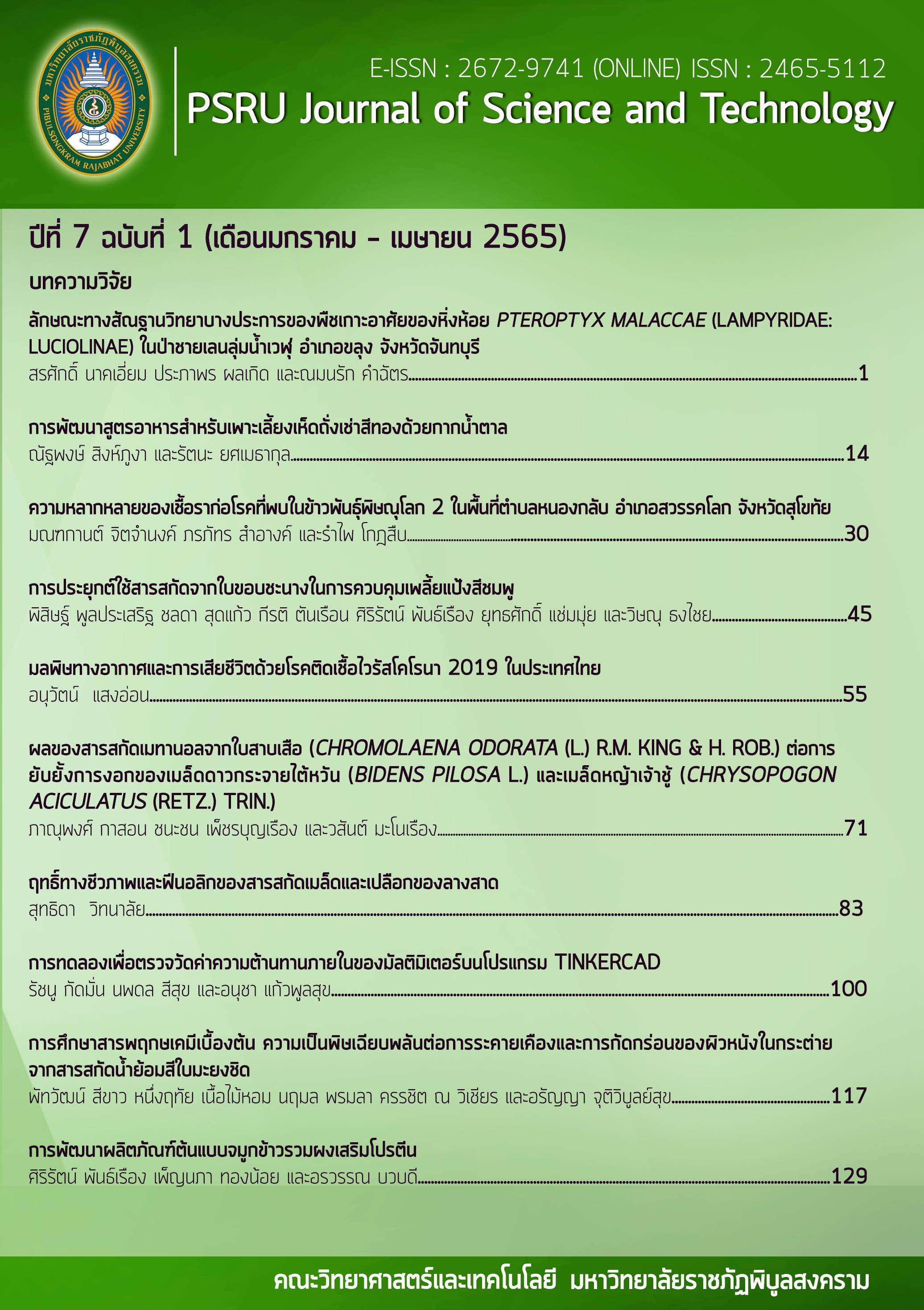BIOACTIVITIES AND PHENOLIC OF LANSIUM DOMESTICUM CORR. EXTRACTS (SEED AND PEEL)
Keywords:
Lansat, Bioactivity, PhenolicAbstract
The seed and peel of Langsat (Lansium domesticum Corr.) were extracted with methanol ethanol and water as solvent and tested for their biological activities. The extracts were tested for their properties included antioxidant activity (DPPH assay, ABTS assay and FRAP assay), antiglycation activity, tyrosinase inhibitor, antibacterial activity, total phenolic contents and HPLC determination of phenolic compounds. The results revealed that methanol peel extract was the most effective extract which showed the highest DPPH radical scavenging activity (48.80±0.09 mg TE/ g DW), tyrosinase inhibitor (181.05±11.09 mg KAE/g DW) and total phenolic contents (27.62±1.37 mg GAE/ g DW). While the peel water extract showed
the highest ABTS radical scavenging activity (128.30±1.41 mg TE/ g DW), ferric reducing antioxidant power (0.88±0.07 mg TE/ g DW ) and antiglycation activity (24.26±5.89 % AGE inhibition). In addition, the seed methanol extract revealed the highest antibacterial activity against Escherichia coli and Staphylococcus sp. The determination of phenolic compounds by HPLC found only protocatechuic acid in both seed and peel extracts. This study indicated that the peel extracts of Langsat was suitable for cosmeceutical product, pharmaceutical products and dietary supplements development with natural ingredient.
References
จันทิมา หอมกลบ, สุพนิดา วินิจฉัย, หทัยรัตน์ ริมคีรี, นคร เหลืองประเสริฐ, และวิชัย หฤทัยธนาสันติ์. (2553). ฤทธิ์ต้านอนุมูลอิสระ ฤทธิ์ยับยั้งเอนไซม์ไทโรซิเนส และปริมาณสารประกอบฟินอลิกทั้งหมดของสารสกัดเอทิลอะซีเตตจากผลมะขามป้อมจากแหล่งในประเทศไทย. ใน การประชุมวิชาการของมหาวิทยาลัยเกษตรศาสตร์ ครั้งที่ 48 (น. 91-99) กรุงเทพฯ: มหาวิทยาลัยเกษตรศาสตร์.
ชมนาด สิงห์หันต์, และไมตรี สุทธจิตต์. (2560). การยับยั้งออกซิเดชันและไกลเคชั่นในโรคเบาหวานโดยผักพื้นบ้านไทย. Naresuan University Journal: Science and Technology, 25(3), 1-11.
ปรัญรัชต์ ธนวิยุทธ์ภัคดี. (2559). ไกลเคชั่นกับการเกิดโรคในมนุษย์. วารสารพิษวิทยาไทย, 31(2), 84-96.
สาโรจน์ จีนประชา. (2555). องค์ประกอบทางเคมีและฤทธิ์ทางเภสัชวิทยาของพืชสกุลลางสาด. วารสารวิทยาศาสตร์และเทคโนโลยี มหาวิทยาลัยอุบลราชธานี, 14(4), 42-52.
สุคนธ์ ตันติไพบูลย์วุฒิ, เทียนชัย น่วมเศรษฐี, และเพชรลดา เดชายืนยง. (2555) ฤทธิ์ยับยั้งแบคทีเรียของสารสกัดจากเปลือกผลไม้บางชนิด. วารสารวิจัย มช, 17(6), 880-894.
สุริยา ทุดปอ, และจิตรา สิงห์ทอง. (2560). สารออกฤทธิ์ทางชีวภาพและกิจกรรมการต้านอนุมูลอิสระของแก่นตะวันที่มีอายุการเก็บเกี่ยวต่างกัน. วารสารวิทยาศาสตร์และเทคโนโลยีมหาวิทยาลัยอุบลราชธานี, 19(3), 45-57.
อมรรัตน์ สีสุกอง, กัลยาภรณ์ จันตรี, และศรีสุดา หาญภาคภูมิ. (2559). การศึกษาฤทธิ์ต้านแบคทีเรียของสารสกัดจากวัชพืชบางชนิด. วารสารวิจัยและพัฒนา วไลยอลงกรณ์ในพระบรมราชูปถัมภ์ สาขาวิทยาศาสตร์และเทคโนโลยี, 11(1), 69-82.
อินทิรา ขูดแก้ว, และพัชรพรรณ สุคนธ์ขจร. (2561). สมบัติต้านอนุมูลอิสระและยับยั้งเอนไซม์ไทโรซิเนสของลำต้น ใบ ดอกและเมล็ดจากเทียนบ้าน. แก่นเกษตร, 46(ฉบับพิเศษ 1), 1242-1247.
Carocho, M. & Ferreira, C.F.R. (2013). A reviews on antioxidants, proxidants and related controversy. Natural and synthetic compounds, screening and analysis methodologies and future perspectives. Food and Chemical Toxicology, 51. 15-25.
Chang, T.S., Ding, H.Y., Tai, S.S.K., & Wu, C.Y. (2007). Mushroom tyrosinase inhibitory effects of isoflavones isolated soygerm koji fermented with Aspergillus oryzae BCRC32288. Food Chemistry, 105(4), 1430-1438.
Gülçin, İ., Oktay, M., Kireçci, E., & Küfreviolu, Ö.İ. (2003). Screening of antioxidant and antimicrobial activities of anise (Pimpinella anisum L.) seed extracts. Food Chemistry, 83(3), 371-382.
Jung, K.L., Lee, S.U., Kozukie, N., Levin, C.E., & Fredman, M. (2011). Distribution of phenolic compounds and antioxidative activities in parts of sweet potato (Ipomoea batata L.) plants and in home processed roots. Journal of Food Composition and Analysis, 24(1), 29-37.
Kaewnarin, K., Shank, L., Niamsup, H., & Rakariyatham, N. (2013). Inhibitory effects of Lamiaceae plants on the formation of advanced glycation endproducts (AGEs) in model proteins. Journal of Medical and Bioengineering, 2(4), 224-227.
Kallar, S., & Bais, S. (2014). A review on protocatechuic acod and its pharmacological potential. ISRN Pharmacology, 2014, 952943, 9 pages.
Klungsupya, P., Suthepakul, N., Muangman, T., Rerk-Am, U., & Thongdon-A, J. (2015). Determination of Free Radical Scavenging, Antioxidative DNA Damage Activities and Phytochemical Components of Active Fractions from Lansium domesticum Corr. Fruit. Nutrients, 7, 6852-6873.
Li, Y., Guo, C., Yang, J., Wei, J., Xu, J., & Cheng, S. (2006). Evaluation of antioxidant properties of pomegranate peel extract in comparison with pomegranate pulp extract. Food Chemistry, 96(2), 254-260.
Ragasa, C.Y., Labrador, P., & Rideout, J.A. (2006). Antimicrobial Terpenoids from Lansium domesticum.
The Philippine Agricultural Scientisi, 89(1), 101-105.
Re, R., Pellegrini, N., Proteggente, A., Pannala, A., Yang, M.,& Rice-Evans C. (1999). Antioxidant activity applying an improved ABTS radical cation decolorization assay. Free Radical Biology and Medicine, 26(9-10), 1231–1237.
Thitilertdecha, N., Teerawutgulrag, A., & Rakariyatham, N. (2008). Antioxidant and antimicrobial activities of Nephalium lappacium L. extracts. LWT-Food Science and Technology, 41(10), 2029-2035.
Downloads
Published
How to Cite
Issue
Section
License
Copyright (c) 2022 PSRU Journal of Science and Technology

This work is licensed under a Creative Commons Attribution-NonCommercial-NoDerivatives 4.0 International License.
กองบรรณาธิการขอสงวนสิทธิ์ในการปรับปรุงแก้ไขตัวอักษรและคำสะกดต่างๆ ที่ไม่ถูกต้อง และต้นฉบับที่ได้รับการตีพิมพ์ในวารสาร PSRU Journal of Science and Technology ถือเป็นกรรมสิทธิ์ของคณะวิทยาศาสตร์และเทคโนโลยี มหาวิทยาลัยราชภัฏพิบูลสงคราม และ
ผลการพิจารณาคัดเลือกบทความตีพิมพ์ในวารสารให้ถือมติของกองบรรณาธิการเป็นที่สิ้นสุด







